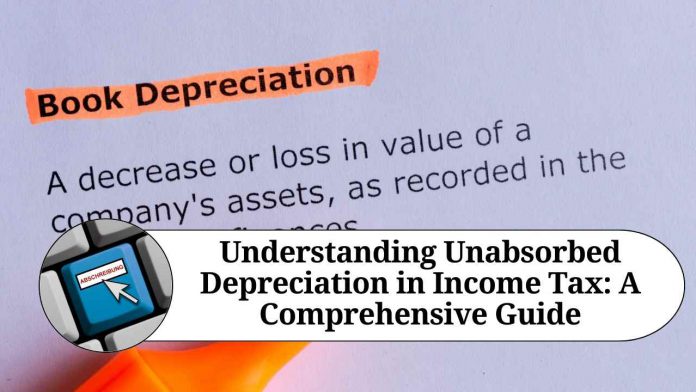Introduction
When it comes to calculating income tax, businesses need to consider various factors, including expenses, deductions, and depreciation. Depreciation is an essential concept that allows businesses to account for the wear and tear of their assets over time. However, what happens when the amount of depreciation claimed exceeds the taxable income? In such cases, unabsorbed depreciation comes into play. In this blog post, we will delve into the intricacies of unabsorbed depreciation in income tax and understand its implications for businesses.
What is Depreciation?
Before we explore unabsorbed depreciation, let’s briefly understand the concept of depreciation. Depreciation refers to the decrease in the value of an asset over time due to factors such as usage, obsolescence, wear and tear, or passage of time. It is a non-cash expense that allows businesses to allocate the cost of an asset over its useful life.
What is Unabsorbed Depreciation?
Unabsorbed depreciation occurs when a business is unable to claim the entire amount of depreciation in a particular financial year due to insufficient profits. In other words, the depreciation expense exceeds the taxable income, resulting in unabsorbed depreciation. This unabsorbed depreciation can be carried forward and set off against future profits for a specified period.
Carry Forward and Set-off of Unabsorbed Depreciation:
In many countries, including India, the income tax laws allow businesses to carry forward unabsorbed depreciation and set it off against future profits. This provision helps businesses utilize the unclaimed depreciation in subsequent years and reduces their tax liability.
The specific rules regarding the carry forward and set-off of unabsorbed depreciation vary across jurisdictions. In some cases, there might be limitations on the number of years for which unabsorbed depreciation can be carried forward or the percentage of profits against which it can be set off. It is crucial for businesses to understand the local tax regulations to make optimal use of their unabsorbed depreciation.
Benefits and Implications:
Tax Optimization:
Unabsorbed depreciation provides an opportunity for businesses to reduce their tax liability in future years. By carrying forward and setting off the unabsorbed depreciation against future profits, businesses can effectively lower their taxable income.
Cash Flow Management:
The ability to carry forward unabsorbed depreciation offers a cash flow advantage for businesses. It allows them to defer the tax liability associated with the unclaimed depreciation and utilize it in the future when profitability improves.
Profitability Challenges:
While unabsorbed depreciation can provide tax benefits, it also reflects a lack of profitability in the immediate term. If a business consistently incurs unabsorbed depreciation, it may indicate underlying financial challenges that need to be addressed.
Compliance and Documentation:
Proper record-keeping and compliance with tax regulations are essential when dealing with unabsorbed depreciation. Maintaining accurate depreciation schedules and financial statements is crucial to ensure smooth carry forward and set-off processes.
Conclusion
Unabsorbed depreciation is an important aspect of income tax calculations for businesses. It allows them to carry forward and set off depreciation that could not be claimed due to insufficient profits. Understanding the rules and regulations governing unabsorbed depreciation is essential for businesses to optimize their tax liabilities and manage cash flow effectively. By leveraging this provision, businesses can navigate the complexities of income tax and ensure compliance while maximizing tax benefits.
Read more useful content:
Frequently Asked Questions (FAQs)
Q1: What is unabsorbed depreciation in income tax?
A1: Unabsorbed depreciation refers to the depreciation expense that a business is unable to claim in a particular financial year due to insufficient profits. It occurs when the amount of depreciation claimed exceeds the taxable income.
Q2: How is unabsorbed depreciation treated in income tax?
A2: In many jurisdictions, including India, unabsorbed depreciation can be carried forward and set off against future profits. This means that businesses can utilize the unclaimed depreciation in subsequent years to reduce their taxable income and lower their tax liability.
Q3: What are the benefits of carrying forward unabsorbed depreciation?
A3: Carrying forward unabsorbed depreciation provides several benefits, including tax optimization and cash flow management. It allows businesses to reduce their tax liability in future years and provides a cash flow advantage by deferring the tax associated with the unclaimed depreciation.
Q4: Can unabsorbed depreciation be carried forward indefinitely?
A4: The rules regarding the carry forward of unabsorbed depreciation vary across jurisdictions. In some cases, there may be limitations on the number of years for which unabsorbed depreciation can be carried forward. It is important for businesses to understand the specific regulations in their respective countries or regions.
Q5: How is unabsorbed depreciation set off against future profits?
A5: Unabsorbed depreciation is typically set off against future profits in the order of priority specified by tax laws. Generally, it is set off against the profits from the same business or profession in subsequent years. The specific rules regarding the set-off of unabsorbed depreciation may vary, and businesses should consult local tax authorities or professionals for accurate guidance.
Q6: What happens if a business incurs consistent unabsorbed depreciation?
A6: Consistent unabsorbed depreciation may indicate underlying financial challenges or profitability issues for a business. It is essential for businesses to analyze the reasons behind unabsorbed depreciation and take appropriate measures to address the underlying issues.
Q7: Are there any documentation and compliance requirements related to unabsorbed depreciation?
A7: Yes, maintaining accurate records and complying with tax regulations are crucial when dealing with unabsorbed depreciation. Businesses should keep proper depreciation schedules, financial statements, and other supporting documentation to ensure compliance and facilitate the carry forward and set-off processes.
Q8: Can unabsorbed depreciation be transferred or used by another entity?
A8: The transferability of unabsorbed depreciation depends on the specific tax laws of the jurisdiction. In some cases, unabsorbed depreciation can be transferred in the event of a merger, acquisition, or restructuring of a business. However, it is important to consult with tax professionals or authorities to determine the transferability rules applicable in a particular situation.
Q9: How can businesses optimize the utilization of unabsorbed depreciation?
A9: To optimize the utilization of unabsorbed depreciation, businesses should carefully plan their future profits and assess the available set-off options. It is advisable to seek guidance from tax experts or professionals who can provide insights into the specific regulations and help in making informed decisions.
Q10: Can unabsorbed depreciation be claimed in case of a loss-making year?
A10: Unabsorbed depreciation can be carried forward and set off against future profits, including those from loss-making years. However, the specific rules and limitations regarding the set-off of unabsorbed depreciation in loss years may vary across jurisdictions. Businesses should consult local tax laws or professionals for accurate information based on their specific circumstances.





















Man, you are a good writer. Your article is really interesting. You should do it professionaly